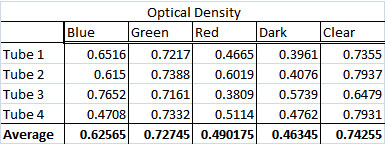Introduction
Some of the surface proteins of Halobacteria are able to sense certain wavelengths of light. When these proteins are activated by the presence of these wavelengths, the flagella of the Halobacteria can become "activated" and the halo may move or not depending on which wavelengths it recognizes. Halo has been shown to be attracted to orange light and repulsed by blue light. We were hoping to see a difference in either the growth rate or phenotype as a result of the halo not receiving all of the wavelengths present in natural sunlight. We covered halo in cellophane that filtered out different types of light and measured the OD and color of the cell pellet.
Procedure
- Add 15 mL of Complete Media to each of the 50mL flasks.
- Add 3 mL of Halobacterium with an OD of about 1.2 to each flask.
- Add a stir stick to each flask.
- Cover four flasks with each of four colors of cellophane for a total of 16 colored flasks.
- Cover the remaining four flasks with aluminum foil
- Cover the top of each flask with a piece of aluminum foil.
- Label the flasks as following:
Blue-1 |
Green-1 |
Red-1 |
Dark-1 |
Clear-1 |
Blue-2 |
Green-2 |
Red-2 |
Dark-2 |
Clear-2 |
Blue-3 |
Green-3 |
Red-3 |
Dark-3 |
Clear-3 |
Blue-4 |
Green-4 |
Red-4 |
Dark-4 |
Clear-4 |
Also label each flask with the date, “Halo NRC-1”, and your initials
- Place each set of four flasks in a cardboard flask holder and put them on a spinner plate.
- Start spinning the plates at level 1 (or lowest level) and record the time.
- Record oxygen level with dissolved oxygen probe each day until experiment ends.
- After 72 hours, micropipette 1.6 mL of each sample into a centrifuge tube.
- Centrifuge the tubes for one minute to spin down cells into a pellet and record observations.
Setup
Results

- There was no noticable difference in the color of the pellets taken from each sample
Conclusion
We found a significant difference in the rate of growth of the halo grown under different wavelength conditions. The Halo grew best in the normal light environment where none of the wavelengths were filtered out. However, the sample in which green light was let through grew nearly as well as the sample receiving all wavelengths (.727 vs. .742 OD). The sample receiving blue light grew third best, followed by the one grown in red light and finally the one grown in no light. We believe the sample grown in red light grew the worst than the rest receiving light because the pigment of Halobacteria is very close to red (usually pinkish or purple), so much of this red light got reflected. We also know that Halo is repulsed by blue light so that may explain why it didn't grow quite as well in blue light as compared to green light.
While our measured growth offered some insight into how Halo reacts to light, our phenotypic observations did not. All of the cell pellets were essentially the same color. This may have been due to experimental error, however. If this experiment were to be repeated, we would have left the light source running the entire experiment instead of turning it off at night.
. |



